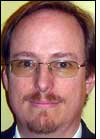Southern Co. has completed a pilot testing an RFID-based system to train employees in how to limit their exposure to radiation. The RFID system, provided by Q-Track, feeds a worker’s location data to software that then calculates the level of exposure that person would have received in a real-world scenario. It’s part of a simulated environment intended to train future employees of the electric utility company’s Plant Vogtle nuclear facility—located in Waynesboro, Ga.—how to gauge their exposure. Staff members are instructed to base their radiation exposure on a floor map of the factory that demarks the locations of radiation hot spots, as well as to employ dosimeter readers displaying the cumulative level of radiation encountered.
William Keith Hodnett, Plant Vogtle’s training department mechanical instructor, described the pilot at a breakout session at RFID Journal LIVE! 2009, held last month in Orlando, Fla.
Nuclear plant employees are limited regarding the amount of radiation to which they can be exposed during any particular period of time without jeopardizing their health. To provide them with the information they require to ensure they avoid spending too much time in an area of high radiation, a health physicist walks through the plant before work begins, measuring radiation levels, then provides the staff with a map indicating the level of radiation in specific areas of the floor.
Employees wear a dosimeter, and are expected to use that device, as well as the map, to monitor their own levels. If a worker receives excessive radiation, the dosimeter sounds an alarm. “The sources of radiation are not just reactors,” Hodnett told LIVE! attendees. Some radioactive particles enter the cooling system and become trapped in welds and bends, he explained, so personnel need to learn not to stand too close—or for too long—near such locations, which could be radiation hot spots.
However, Hodnett noted, before employees even enter the plant floor, they must complete a training process to ensure they understand how to use the map and dosimeter to reduce exposure prior to entering the real-world environment. In the past, the company provided such training with cameras, recording footage of each worker’s location in the simulated plant floor. Instructors could then review the video and determine that individual’s behavior, including whether or not he was receiving an excessive amount of radiation, and whether he was following the map provided by the health physicist.
Southern Co. had sought a better training method that would more closely approximate the environment in which the employees would work. In 2007, the power company approached Q-Track, a startup firm based in Huntsville, Ala. In response, Q-Track developed a system utilizing its near-field electromagnetic ranging (NFER) system. The solution features a QT500 battery-powered RFID tag that attaches to a belt. Although it does not actually measure radiation—of which there is none in the simulated plant—the tag receives an instruction from the Q-Track software to display radiation measurements based on where the employee is standing in the simulated plant floor. If the software is instructed that a particular location is highly radioactive, for instance, and if a trainee wearing a Q-Track tag spends too much time in that location, the tag’s LCD displays that person’s high level of radiation exposure. What’s more, if the amount reaches a predetermined threshold, the tag sounds an alarm.The system spent approximately a year in development, says Hans Schantz, Q-Track’s CTO. The solution capitalizes on Q-Track’s NFER technology, which employs very low radio frequencies (approximately 1 MHz) to measure location. When the tag transmits an RF signal, its electrical and magnetic waves are initially out of sync. With a system that operates at a higher radio frequency, RFID interrogators pick up a tag’s RF signal after the electrical and magnetic waves have converged. But Q-Track’s readers, because they operate at very low frequencies, can detect a tag signal’s electrical and magnetic components with separate antennas, and measure the tag’s distance from the reader based on the phase difference between the electrical and magnetic waves.
The plant required a system that could cover the 100- by 50-foot plant (that includes a ground floor and mezzanine level), with an accuracy of approximately 1 foot. The system also had to work around the types of obstacles generally found within a nuclear power plant—typically, water pumps and storage tanks.
To achieve such location accuracy, Q-Track installed eight receivers, each with three antennas. The receivers read each QT500 tag not by means of a unique ID number encoded to that tag, but rather by the specific radio frequency it emits (the system can accommodate up to 1,000 tags, with each tag’s assigned frequency varying from the next by 1.5 kHz). The system recognizes the frequency of the specific tag’s transmission, and links that signal with the name of the employee wearing that particular tag. During the training process, the Q-Track system can monitor the positions of up to 10 trainees simultaneously, receiving data transmitted from the tags to allow the software to calculate the radiation dose each worker receives, in simulation. Alarm points are set up in the system so that if a radiation threshold is being crossed, the device emits a loud warning signal to prompt the user to leave the environment.
At the plant simulation center, Hodnett said, Southern Co. instructs its trainees to “practice like you play.” There is greater pressure on nuclear employees and contractors as refueling cycles drop, thus requiring workers to complete their tasks more quickly. “We want all radiation workers to receive the minimum dose,” he told the audience. “The lower the person’s dose, the better we all are.” Plants feel further pressure, he added, as the workforce gets older; those who have already learned radiation skills are retiring, and new workers need to be trained.
According to Hodnett, radiation exposure is a significant concern. Each plant receives a rating based on the total dose per year that each worker receives. At Southern, he said, “Our goal is to be on the bottom of the list.” But without the proper training, staff members may unnecessarily expose themselves to radiation. “If a worker is getting up towards the top limit, that bars them from doing certain activities in the plant, which creates scheduling difficulties.”
The system, which commenced as a pilot in November 2008, is now a full deployment. Southern Co. also has the technology on display at its headquarters in Atlanta, to demonstrate to its own staff and visitors how it is being used for tracking trainees at Plant Vogtle.



